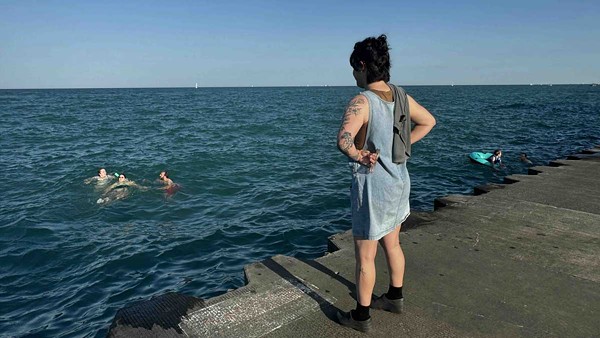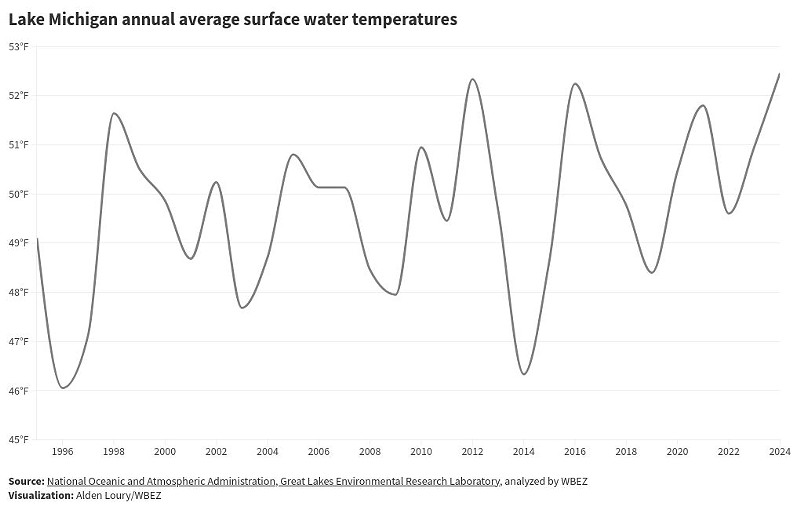This coverage is made possible through a partnership between WBEZ and Grist, a nonprofit, independent media organization dedicated to telling stories of climate solutions and a just future. Sign up for WBEZ newsletters to get local news you can trust.
On a sunny, mid-September afternoon, Olu Demuren took a running start off the concrete ledge just south of Belmont Harbor and lept into Lake Michigan for the first time.
“I was preparing myself for cold water,” Demuren said. “And this immediately felt very nice.”
The water along Chicago’s lakeshore averaged an unseasonable 71 degrees that day. The weather was picturesque too: clear blue skies and temperatures in the mid-80s. Anneliese Rittberg watched their friends from the concrete ledge and said the weather felt “deeply abnormal.”
“While it’s fun to be out here, it’s also unsettling,” Rittberg said.
Lake Michigan’s surface temperature nearly every day this year has surpassed the running average dating back to 1995, according to National Oceanic and Atmospheric Administration (NOAA) data. And it’s not just one Great Lake. All five are heating up. The massive bodies of water, which provide drinking water to more than 30 million people, are among the fastest-warming lakes worldwide, according to the federal government’s Fifth National Climate Assessment.
It’s a trend that doesn’t show any sign of slowing. As heat trapping-greenhouse gasses continue to accumulate in the atmosphere, the Great Lakes region is projected to grow warmer and wetter in the years and decades to come. Over a fifth of the world’s supply of non-frozen freshwater flows through the five connected Great Lakes, forming the Earth’s largest freshwater ecosystem.
Lake Michigan started the year at around 42 degrees. That’s the hottest temperature on the first of the year since scientists started keeping track in 1995.
“On average, right now and for the past few years, we’ve been above the norm and above the trend for this satellite data record we have for temperature,” said Andrea Vanderwoude, a satellite oceanographer at NOAA’s Great Lakes Environmental Research Laboratory (GLERL).
She adds that several of the warmest years on record have occurred in the past decade. This summer was warm on the whole, but by itself did not set records. Winter temperatures, however, did.
“Winters are in fact, getting warmer and warmer, both in the lakes and in the air and the land around us,” said Drew Gronewold, a professor of environmental sciences at the University of Michigan. “Winter is vanishing from the Great Lakes.”
Average winter temperatures in the upper Midwest are several degrees warmer today compared to 50 years ago. This is important because how heat accumulates in the lakes in one season largely determines what happens the following season.
As a result, lakes that have consistently experienced seasonal ice cover since the last glacial stage are today seeing less and less of it. According to an analysis by GLERL, ice cover fell by approximately 5% per decade between 1973 and 2023. Today, there’s around 25% less ice cover than there was 50 years ago. This year has been the fourth lowest year for ice cover across the Great Lakes on record.
“This past ice year was one of the lowest ever,” said Gronewold. “Much of that time period was at record lows, and that is really a sort of the shade of things to come.”
Still, despite the warming trends, scientists said ice won’t be completely disappearing from the Great Lakes any time soon.
As Rose Sawyer dried off from her dip in the lake, she said that as far as she remembers, Lake Michigan has always varied.
“It’s weird to be swimming here this late, but it’s also just like the lake is kind of a constantly changing thing,” Sawyer said. “It’s not like a static object.”
While it’s true that Lake Michigan, like all the Great Lakes, have always shown variability from year to year, the overall trends conform with a global shift toward a warmer planet. That won’t just mean longer beach seasons on Chicago’s lakefront. It’ll mean a longer commercial shipping season, changing migratory patterns for fish and more intense storms. Here on Chicago’s lakefront, it will mean even more erosion and smaller beaches.
In the meantime, Demuren and their friends say that even if they are all out of 85 degree Chicago beach days, they’ll probably keep jumping into the lake anyway — until, eventually it becomes intolerably cold.
This story was originally published on September 27, 2024.



